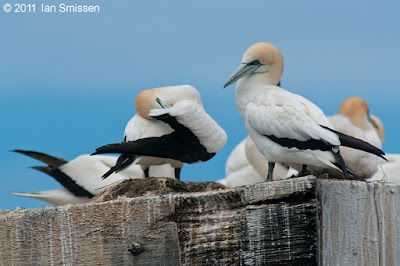 |
| Beach walking on Mud Islands |
One of the highlights of the walk around the islands was seeing the Pelican creche on one of the inner lagoons.
 |
| Australian Pelican, Mud Island |
In addition to the creche, Australian Pelicans could be seen resting and preening all over the lagoon.
 |
| Australian Pelican, Mud Islands |
There are extensive sand banks on the north and west shores providing feeding grounds for a wide range of waders. I managed to see Red-capped Plover, Ruddy Turnstone, Double-banded Plover, Pacific Golden Plover, Grey Plover, Red Knot, Great Knot, Sharp-tailed Sandpiper, Bar-tailed Godwit, Australian Pied Oystercatcher, Sooty Oystercatcher and, of course, Red-necked Stints
 |
| Red-necked Stint, Mud Islands |
This bird came very close while I was photographing a juvenile Australasian Gannet resting on the sandbank
 |
| Australasian Gannet (juvenile), Mud Islands |
This Red Knot also allowed fairly close approach. It's amazing how close you can get to these birds with some patience and staying low.
 |
| Red Knot, Mud Islands |
...and it was not all birds. An Australian Fur Seal was sun baking on the sand banks as we walked back along the beach
 |
| Australian Fur Seal, Mud Islands |
On the way back to Sorrento, we passed by one of the channel markers with it's small colony of Australasian Gannets. It was great to see them close up, including more juveniles and some late season downy chicks, but difficult to photograph, hand holding a long lens while jostling for position with 30+ eager birdwatchers on a moving boat...
 |
| Australasian Gannet, Channel Marker, Port Phillip Bay |
A brilliant day. Thanks to Tania and BayBOCA.












































